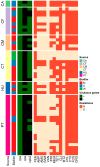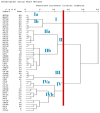Genetic Relatedness, Antibiotic Resistance, and Effect of Silver Nanoparticle on Biofilm Formation by Clostridium perfringens Isolated from Chickens, Pigeons, Camels, and Human Consumers
- PMID: 35324837
- PMCID: PMC8949260
- DOI: 10.3390/vetsci9030109
Genetic Relatedness, Antibiotic Resistance, and Effect of Silver Nanoparticle on Biofilm Formation by Clostridium perfringens Isolated from Chickens, Pigeons, Camels, and Human Consumers
Abstract
In this study, we determined the prevalence and toxin types of antibiotic-resistant Clostridium perfringens in chicken, pigeons, camels, and humans. We investigated the inhibitory effects of AgNPs on biofilm formation ability of the isolates and the genetic relatedness of the isolates from various sources determined using RAPD-PCR. Fifty isolates were identified using PCR, and all the isolates were of type A. The cpe and cpb2 genes were detected in 12% and 56% of the isolates, respectively. The effect of AgNPs on biofilm production of six representative isolates indicated that at the highest concentration of AgNPs (100 µg/mL), the inhibition percentages were 80.8-82.8%. The RAPD-PCR patterns of the 50 C. perfringens isolates from various sources revealed 33 profiles and four clusters, and the discriminatory power of RAPD-PCR was high. Multidrug-resistant C. perfringens isolates are predominant in the study area. The inhibition of biofilm formation by C. perfringens isolates was dose-dependent, and RAPD-PCR is a promising method for studying the genetic relatedness between the isolates from various sources. This is the first report of AgNPs' anti-biofilm activity against C. perfringens from chickens, pigeons, camels, and humans, to the best of our knowledge.
Keywords: Clostridium perfringens; RAPD-PCR genotyping; biofilm inhibition; silver nanoparticles; toxinotyping.
Conflict of interest statement
The authors declare no conflict of interest.
Figures




Similar articles
-
Insights on toxin genotyping, virulence, antibiogram profiling, biofilm formation and efficacy of disinfectants on biofilms of Clostridium perfringens isolated from poultry, animals and humans.J Appl Microbiol. 2021 Mar;130(3):819-831. doi: 10.1111/jam.14838. Epub 2020 Sep 15. J Appl Microbiol. 2021. PMID: 32881183
-
Molecular genotyping, biofilm formation and antibiotic resistance of enterotoxigenic Clostridium perfringens isolated from meat supplied to school cafeterias in South Korea.Anaerobe. 2018 Aug;52:115-121. doi: 10.1016/j.anaerobe.2018.06.011. Epub 2018 Jun 22. Anaerobe. 2018. PMID: 29936108
-
Prevalence and multilocus sequence typing of Clostridium perfringens isolated from retail chicken products and diseased chickens in Tai'an region, China.Vet Med Sci. 2021 Nov;7(6):2339-2347. doi: 10.1002/vms3.616. Epub 2021 Sep 18. Vet Med Sci. 2021. PMID: 34535963 Free PMC article.
-
Genetic diversity of Clostridium perfringens type A isolates from animals, food poisoning outbreaks and sludge.BMC Microbiol. 2006 May 31;6:47. doi: 10.1186/1471-2180-6-47. BMC Microbiol. 2006. PMID: 16737528 Free PMC article.
-
Alpha toxin production potential and antibiotic resistance patterns of clostridium perfringens isolates from meat samples.Anim Biosci. 2024 Nov;37(11):1970-1978. doi: 10.5713/ab.24.0210. Epub 2024 Jun 25. Anim Biosci. 2024. PMID: 38938034 Free PMC article.
Cited by
-
Evaluation of the Accumulation, Distribution, and Excretion of Different Silver Species in Tissues and Feces from Chickens and Pigs Fed with Silver-Based Nanomaterial Supplemented Feeds.ACS Agric Sci Technol. 2025 Feb 25;5(4):454-460. doi: 10.1021/acsagscitech.4c00338. eCollection 2025 Apr 21. ACS Agric Sci Technol. 2025. PMID: 40458757 Free PMC article.
-
Epidemiology and diagnostic accuracy of Clostridium perfringens toxins in the intestinal contents of camels, sheep, and cattle: a cross-sectional study in Dakahlia governorate, Egypt.Trop Anim Health Prod. 2024 Jul 13;56(6):205. doi: 10.1007/s11250-024-04034-7. Trop Anim Health Prod. 2024. PMID: 39001933 Free PMC article.
-
Genome MLST scheme for tracing genetic diversity and multidrug resistance of food animal-derived Clostridium perfringens.Curr Res Food Sci. 2025 Jul 20;11:101149. doi: 10.1016/j.crfs.2025.101149. eCollection 2025. Curr Res Food Sci. 2025. PMID: 40735630 Free PMC article.
-
Cellulose Nanocrystal/Zinc Oxide Bio-Nanocomposite Activity on Planktonic and Biofilm Producing Pan Drug-Resistant Clostridium perfringens Isolated from Chickens and Turkeys.Antibiotics (Basel). 2025 Jun 3;14(6):575. doi: 10.3390/antibiotics14060575. Antibiotics (Basel). 2025. PMID: 40558165 Free PMC article.
References
-
- Wernery U., Seifert H.S., Billah A.M., Ali M. Predisposing factors in enterotoxemias of camels (Camelus dromedarius) caused by Clostridium perfringens type A. Rev. Elev. Med. Vet. Pays Trop. 1991;44:147–152. - PubMed
LinkOut - more resources
Full Text Sources
Research Materials
Miscellaneous

